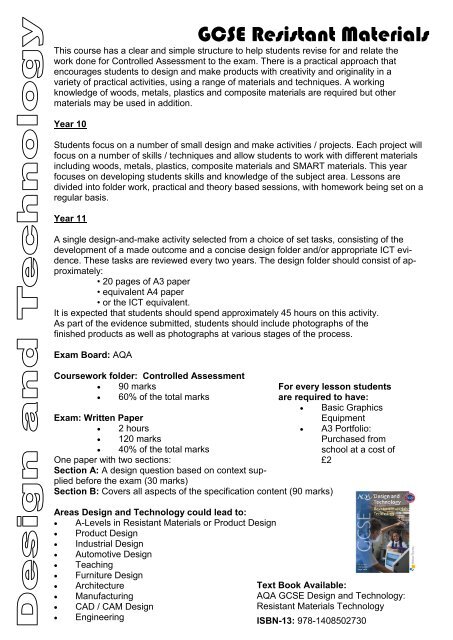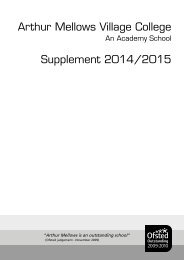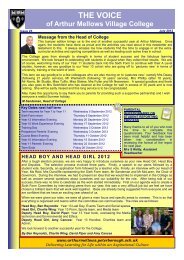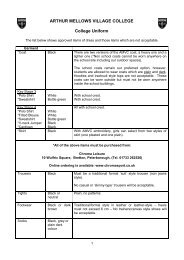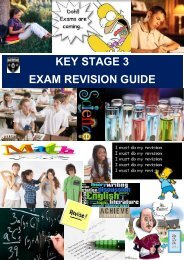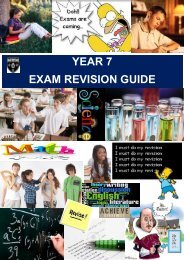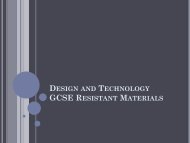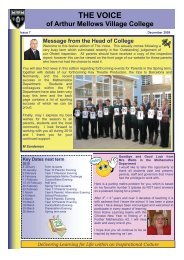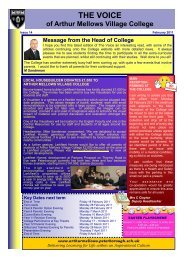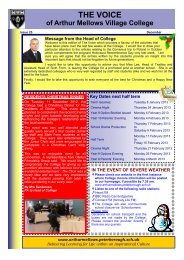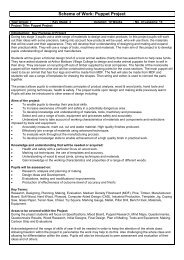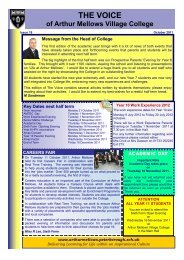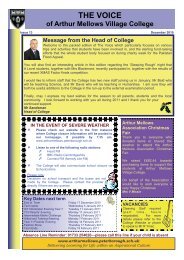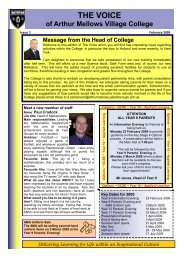GCSE Resistant Materials
GCSE Resistant Materials
GCSE Resistant Materials
Create successful ePaper yourself
Turn your PDF publications into a flip-book with our unique Google optimized e-Paper software.
<strong>GCSE</strong> <strong>Resistant</strong> <strong>Materials</strong><br />
This course has a clear and simple structure to help students revise for and relate the<br />
work done for Controlled Assessment to the exam. There is a practical approach that<br />
encourages students to design and make products with creativity and originality in a<br />
variety of practical activities, using a range of materials and techniques. A working<br />
knowledge of woods, metals, plastics and composite materials are required but other<br />
materials may be used in addition.<br />
Year 10<br />
Students focus on a number of small design and make activities / projects. Each project will<br />
focus on a number of skills / techniques and allow students to work with different materials<br />
including woods, metals, plastics, composite materials and SMART materials. This year<br />
focuses on developing students skills and knowledge of the subject area. Lessons are<br />
divided into folder work, practical and theory based sessions, with homework being set on a<br />
regular basis.<br />
Year 11<br />
A single design-and-make activity selected from a choice of set tasks, consisting of the<br />
development of a made outcome and a concise design folder and/or appropriate ICT evidence.<br />
These tasks are reviewed every two years. The design folder should consist of approximately:<br />
• 20 pages of A3 paper<br />
• equivalent A4 paper<br />
• or the ICT equivalent.<br />
It is expected that students should spend approximately 45 hours on this activity.<br />
As part of the evidence submitted, students should include photographs of the<br />
finished products as well as photographs at various stages of the process.<br />
Exam Board: AQA<br />
Coursework folder: Controlled Assessment<br />
90 marks<br />
For every lesson students<br />
60% of the total marks<br />
are required to have:<br />
Basic Graphics<br />
Exam: Written Paper<br />
Equipment<br />
2 hours<br />
A3 Portfolio:<br />
120 marks<br />
Purchased from<br />
40% of the total marks<br />
school at a cost of<br />
One paper with two sections:<br />
£2<br />
Section A: A design question based on context supplied<br />
before the exam (30 marks)<br />
Section B: Covers all aspects of the specification content (90 marks)<br />
Areas Design and Technology could lead to:<br />
A-Levels in <strong>Resistant</strong> <strong>Materials</strong> or Product Design<br />
Product Design<br />
Industrial Design<br />
Automotive Design<br />
Teaching<br />
Furniture Design<br />
Architecture<br />
Text Book Available:<br />
Manufacturing<br />
AQA <strong>GCSE</strong> Design and Technology:<br />
CAD / CAM Design<br />
<strong>Resistant</strong> <strong>Materials</strong> Technology<br />
Engineering<br />
ISBN-13: 978-1408502730
<strong>GCSE</strong> <strong>Resistant</strong> <strong>Materials</strong><br />
Course Requirements<br />
<br />
<br />
<br />
<br />
<br />
You are required to have the following equipment with you EVERY lesson without fail:<br />
Pens, Pencils and other graphics equipment.<br />
A3 Folder (which you can purchase from the Design and Technology Department for<br />
£2).<br />
Colouring pencils will be provided in lessons but it is helpful to have your own set for<br />
homework.<br />
Homework must be completed to the best of your ability and handed in on time.<br />
Detentions will be issued to poor, incomplete or lack of homework.<br />
A revision folder will be provided. You must keep your A3 folder and revision folder<br />
neat and tidy.<br />
Projects<br />
You will complete the following projects throughout Year 10:<br />
Graphic Skills: Students will focus on and develop their skills of Perspective<br />
Drawing, Isometric Drawing, One and Two Point Perspective, 3rd Angle<br />
Projection, Sketching and shading. These skills are required throughout the two<br />
year course.<br />
<br />
<br />
<br />
<br />
Wood Focus: Wooden Toy Project: Pupils will manufacture a wooden toy<br />
containing a variety of mechanisms, different types of wood and use of wood<br />
joints. A range of wood joining techniques will be researched and considered for<br />
this project.<br />
Plastics Focus: Timer project: Pupils will manufacture a small timing device<br />
that will contain a vacuum formed base, acrylic front and electronic circuit board.<br />
Metal Focus: Mini Plane Project: Pupils will manufacture a mini plane artefact<br />
for wood using a range of tools and machinery.<br />
Design Task: Clock Project: Students are required to design and make a clock<br />
that will incorporate aspects of design eras from the past 100 years. It must also<br />
use a range of different materials and joining techniques.<br />
<br />
<br />
Towards the end of Year 10 you will begin your <strong>GCSE</strong> Coursework Folder. ALL of<br />
your Year 10 work will be valuable to help with this and revision for the exam.<br />
You will have practice style exam questions throughout year 10 and 11 set for<br />
homework and in lessons.<br />
Support<br />
<br />
<br />
<br />
Use technologystudents.com for your first point of call when completing any research.<br />
It is designed for students and explains concepts in a clear and understandable way.<br />
The Design and Technology department holds an extra support session after school<br />
(The evening the extra bus service is available – simply inform student services that<br />
you are saying to reserve a seat in advance). These sessions will focus on:<br />
Help with homework<br />
Catch up on class work<br />
Support on a particular topic<br />
Carry out personal projects<br />
Workshops and Technology Staff are available EVERY lunchtime.


